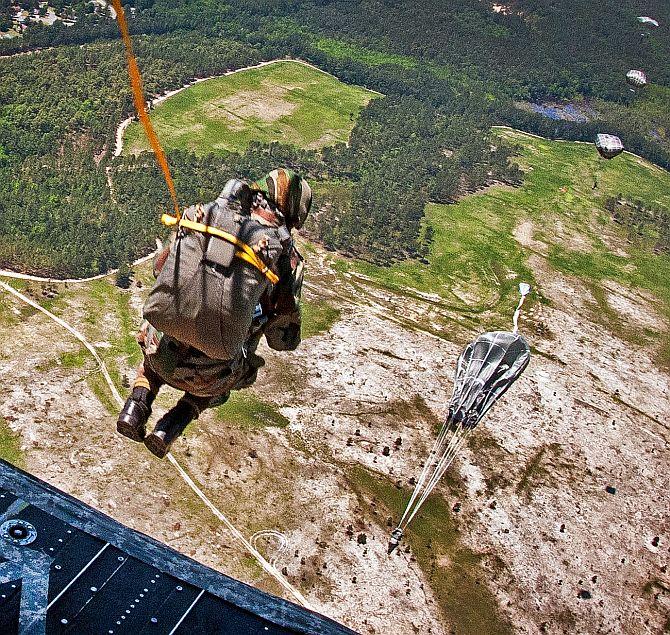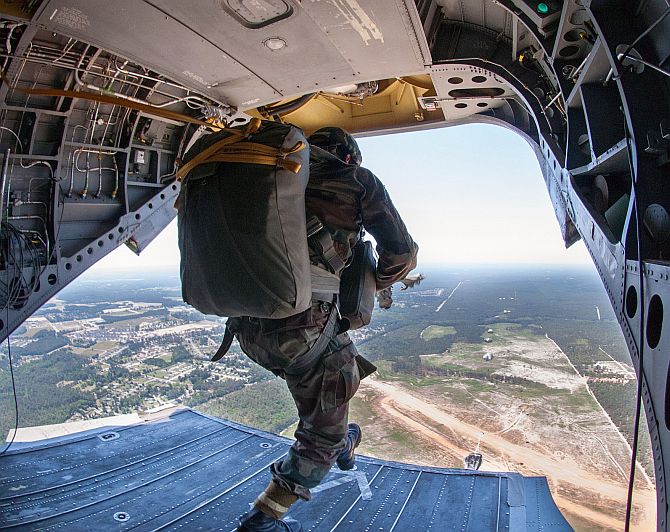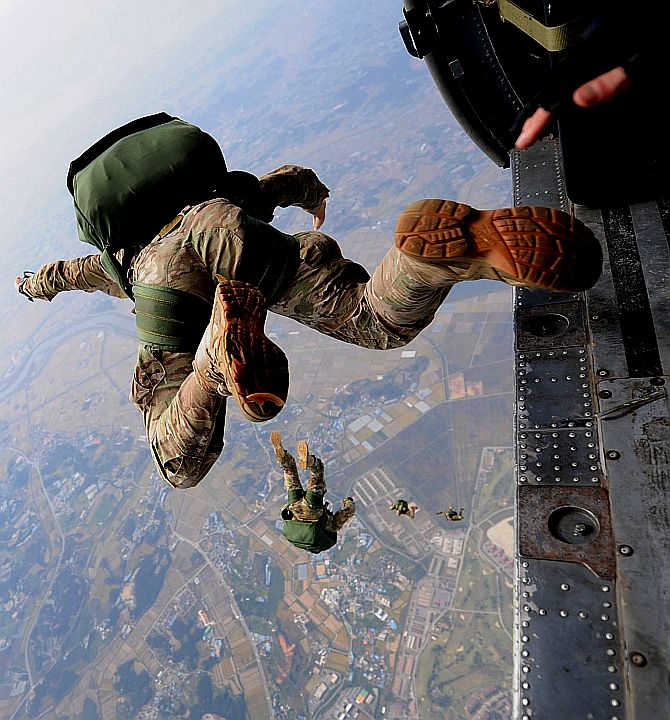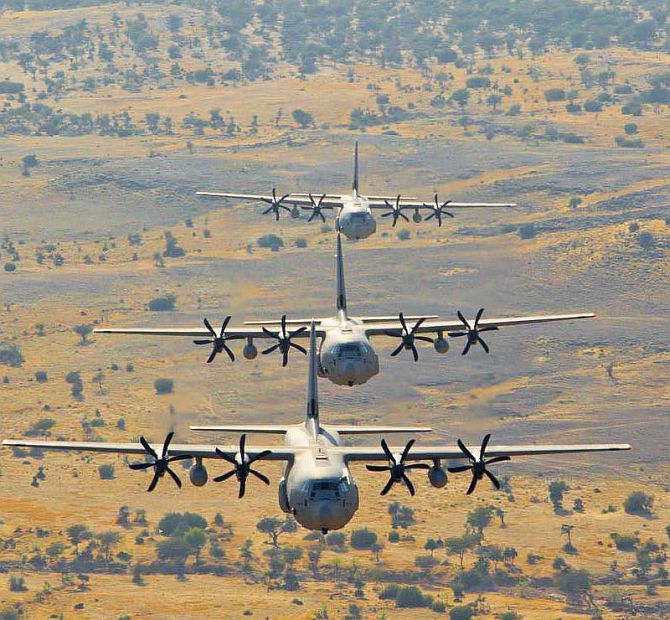 | « Back to article | Print this article |
Surprise from the sky: How paratroopers shape the battle
'No matter how many jumps you do, every jump is like the first one -- you really don't know what awaits you on the way down and in the darkness below...'
'Among all the air-land operations in pursuit of a common military objective, it is the airborne operation which demands the greatest synergy...'
'If there is a pivot, the hammer cannot be far behind... it is the superbly fit and trained paratrooper who delivers the final blow.'
On the occasion of Army Day, Air Vice Marshal Arjun Subramaniam reflects on airborne operations.
I am just back from the deserts of Rajasthan where I witnessed a routine, simulated, but spectacular airborne operation involving hundreds of crack paratroopers from the Indian Army's elite para brigade and numerous transport and fighter aircraft of the Indian Air Force.
As hundreds of tightly strung out parachutes drifted serenely down in the dispersed moonlight, it is important to know that accompanying that visual spectacle was a reality that the collective adrenalin coming down would have matched that of the gladiators in the coliseum of Rome of yesteryears.
As an experienced paratrooper general witnessing the operation remarked "No matter how many jumps you do, every jump is like the first one -- you really don't know what awaits you on the way down and in the darkness below."
Sipping a hot cuppa along with some trademark shakarpara, one could not but admire the dashing brigade commander with a black bandana coming up to report that all his troops and equipment had gathered into fighting formation; or the transport aircraft coordinator on ground, himself an experienced pilot, announce that all the aircraft in tight formation had made their TOT (Time over Target) to the second.
Kindly click NEXT to read further...
Surprise from the sky: How paratroopers shape the battle
Airborne operations have been few since the end of World War II. Amongst the fairly large operations conducted have been the ones by Pakistan and India in the 1965 and 1971 wars respectively.
While the Pakistani operation, which involved the dropping of 60 paratroopers each around five Indian airfields, was a total failure, the Indian Army's battalion group drop at Tangail was a terrific success as the force managed to cut-off retreating Pakistani troops as they fell back to Dacca.
In more recent times, a battalion of US Rangers was dropped to secure the Kandahar airfield in 2001, while a US airborne brigade was dropped in northern Iraq for varied tasks during Operation Iraqi Freedom in 2003.
Military para-trooping operations are generally of two kinds, both of which involve close and integrated planning with the air force. The first kind involves dropping of large numbers of troops behind enemy lines in conventional conflict.
These numbers can vary from a few hundred in what is commonly called in India as a battalion group drop, to a couple of thousands, called a brigade drop.
Only few countries -- US, Russia and China -- probably have the capability to drop more at one go in what is termed a division drop.
Kindly click NEXT to read further...
Surprise from the sky: How paratroopers shape the battle
The typical roles for such forces involve the capture of vital objectives behind enemy lines that will either act as a force multiplier for ongoing operations, or create disproportionate strategic effects that could influence the course of a battle, or even the entire war.
The USP of para-forces in conventional conflict is that they are expected to be self-sufficient and capable of holding their own against numerically superior forces till a link-up is established with advancing formations.
The second kind of para-operations involves super-specialised combat troops like the US Army's Delta Force or Para Commandos of the Indian Army.
Operating in small teams, these troops are trained for stealthy operations with varied objectives and missions across the spectrum of conflict.
Raids on vital installations deep inside enemy territory and decapitation missions against adversary leadership are typical missions for such forces.
These forces are generally accomplished marksmen, demolition experts and skilled in unarmed combat -- closest to a young boy's image of 'Superman'.
Amongst all the air-land operations in pursuit of a common military objective, it is the airborne operation which demands the greatest synergy.
Leave alone in war, planning for a typical peace-time sequence commences months in advance.
Kindly click NEXT to read further...
Surprise from the sky: How paratroopers shape the battle
Airborne operations are inherently risky because of the prolonged exposure to various kinds of enemy fire, be it in the air, or on ground after the landing.
The possibility of interdiction by numerically superior enemy forces is always high and therefore a thorough risk versus reward analysis has to be carried out at the planning stage itself.
Only if disproportionate effects can be achieved with minimum loss will the operation be cleared at the highest level.
After force levels, selection of dropping zones and allocation of air resources are done, training schedules are worked out at the operational level to fine-tune procedures.
Face-to-face briefings and operational drills with go-no-go criteria and other emergency procedures are practiced to perfection -- nothing is left to chance -- only a certain 'Mr Murphy' can put a spanner in the operation if all were to go as rehearsed.
The pivot on which rests the success of any airborne operation is the manner in which the transport aircraft stealthily fly into the combat zone, drop their load comprising paratroopers and equipment ranging from tanks to field artillery guns and more, and return to their launch bases safely.
Kindly click NEXT to read further...
Surprise from the sky: How paratroopers shape the battle
Typically, a battalion of approximately 800 troops with all its associated equipment will need between 15 to 18 aircraft of the C-130 class, which Pakistan has in greater numbers, or in India's case, a mix of various aircraft like the IL-76, AN-32 and C-130.
It is only reasonable to suppose that such large formations would require fighter protection, electronic warfare and radar cover.
Combat Search and Rescue Helicopters would be airborne and ready to swing into action should the force suffer casualties -- the CSAR mission is vital for maintaining morale.
Thus, a battalion-sized airborne force is actually a huge airborne package of transport aircraft, fighter and EW escorts, CSAR helicopters and even an AWACs to provide airborne radar cover and warn the huge formation if any enemy fighter threat emerges as it approaches the target area.
If there is a pivot, the hammer cannot be far behind and it is the superbly fit and trained paratrooper who delivers the final blow.
Putting their fears of the unknown behind and gathering quickly at pre-planned RV points, they deliver the surprise punch and shape the battlefield for the larger forces following to exploit in the days ahead.
I sincerely hope that after reading this piece, a few youngsters will aspire to wear the red beret and fly a couple of those jets and helicopters.
Arjun Subramaniam is a serving air vice marshal in the Indian Air Force. The views expressed are personal.




